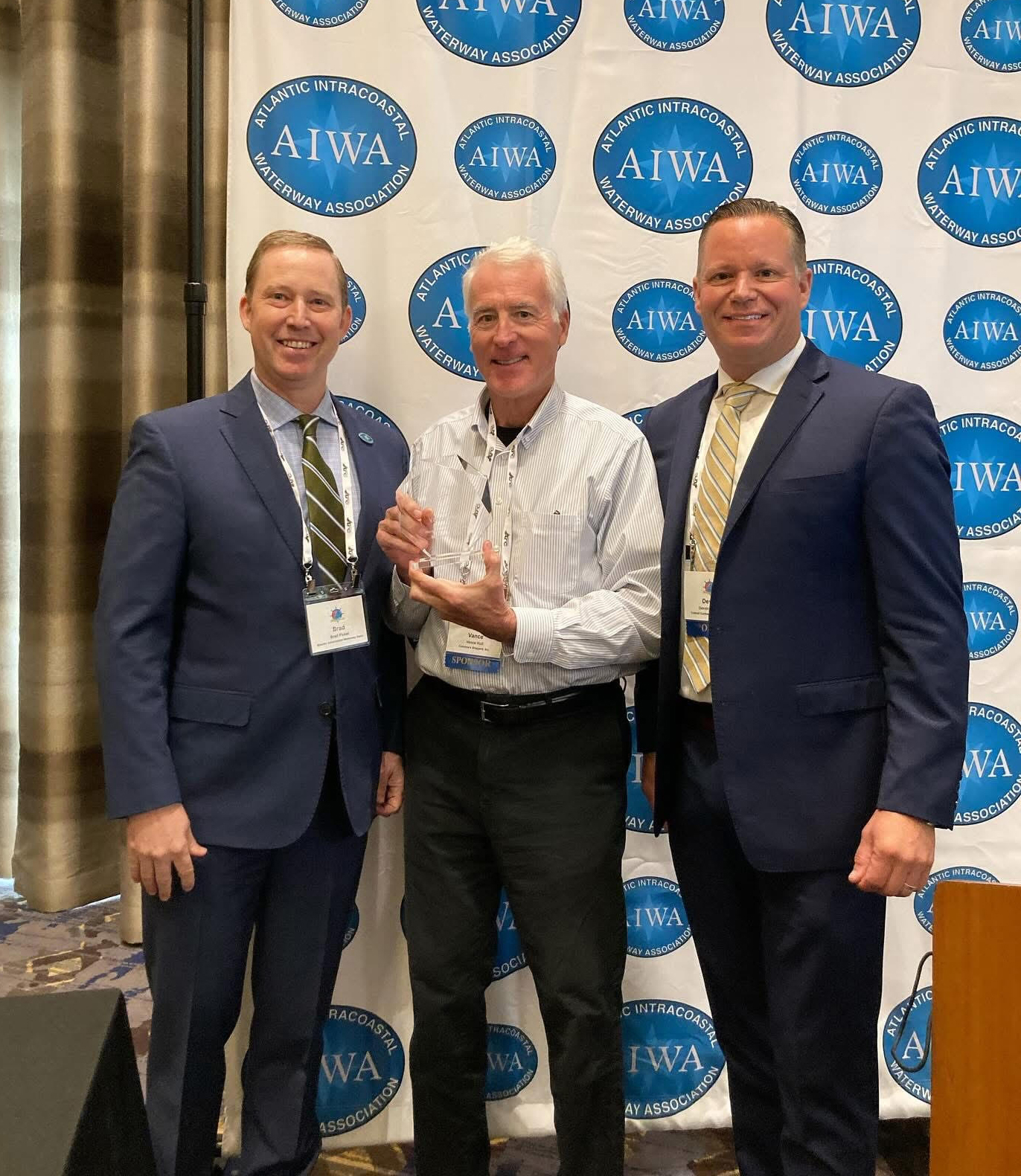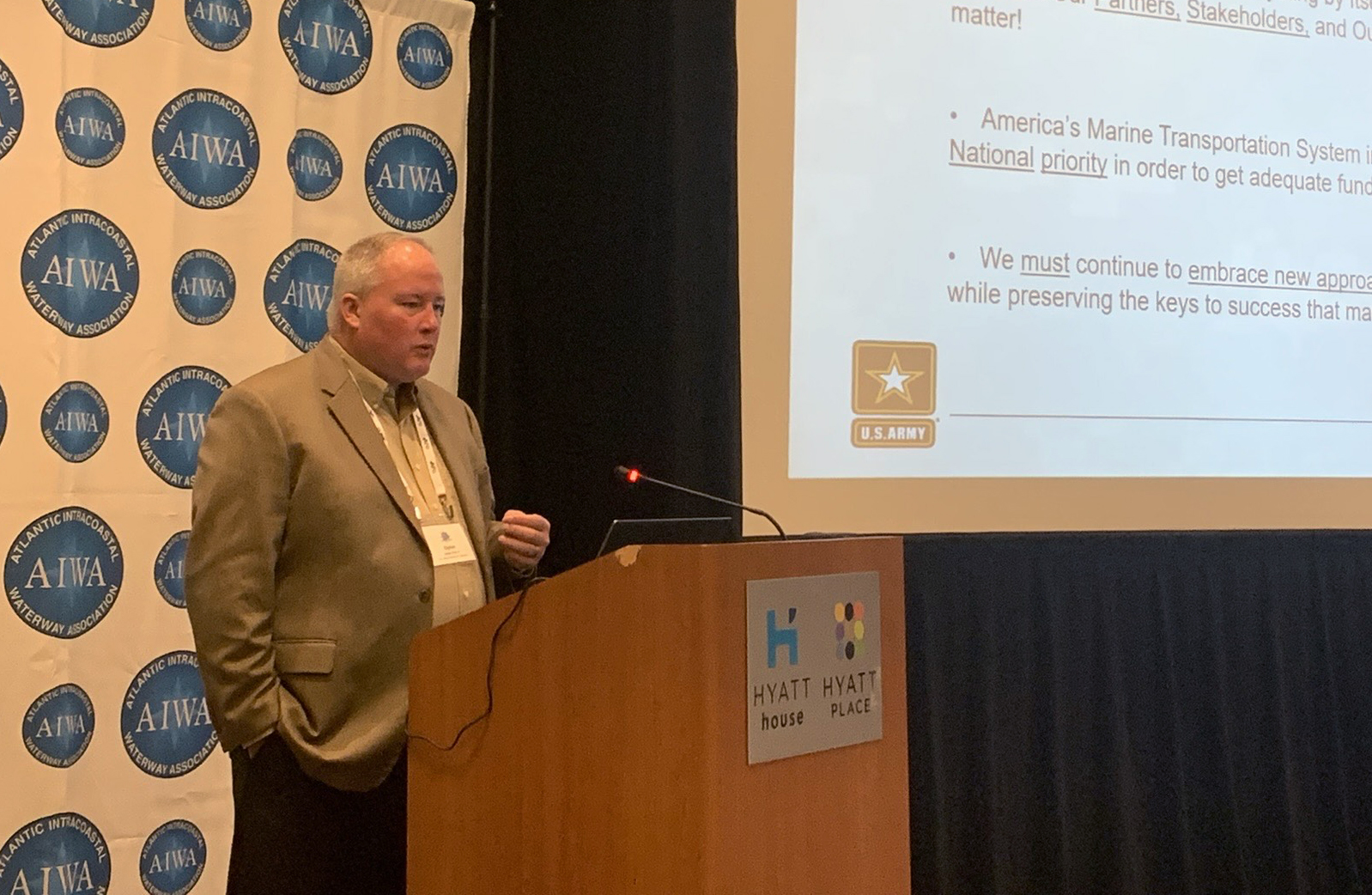AIWA Stakeholders Gather For Annual Meeting
Eighty stakeholders of the Atlantic Intracoastal Waterway Association (AIWA) gathered at the Hyatt Place Historic District in Charleston, S.C., November 18–20 for the organization’s annual meeting. Brad Pickel, executive director of AIWA, said it was the largest attendance in the 25-year history of the association.
The Atlantic Intracoastal Waterway (AIWW) is a 1,100-mile-long protected shipping channel authorized by the Rivers and Harbors Act of 1927 that offers a 12-foot navigable channel from Key West, Fla., to Norfolk, Va. Mile 0 of the waterway is at Norfolk. The stretch from Fort Pierce, Fla., to Miami is maintained at 10 feet.
“We have had dredging projects funded in every state for about the last five years,” Pickel said. “All of the waterway is open, but in some places commercial users have to wait for a rising or high tide. We also had a large focus on beneficial use of dredged material and natural infrastructure. It is our belief that the intracoastal waterway material could be a valuable resource for coastal resilience projects along the waterway and on the beachfront.”

Dylan Davis, in his South Atlantic Division (SAD) update, reported that funding has risen from $1.9 million in 2013 for the Wilmington District only to a total of $43,225,000 in fiscal year 2024 for all four districts in the SAD: Wilmington, Charleston, Savannah and Jacksonville.
Waterway managers in each of the Corps districts that overlay the AIWW presented status reports at the conference.
Virginia Report
Walter Trinkala, AIWW project manager the Norfolk Engineer District, part of the North Atlantic Division, explained that the Norfolk District section of the AIWW “is divided into two canals, the Albemarle and Chesapeake Canal (ACC) and Dismal Swamp Canal (DSC). Both are on the National Register of Historic Places. The project Includes two highway drawbridges, one highway swing bridge, three navigation locks, three water control structures, approximately 40 miles of canal waterways, all real property facilities, and approximately 3,100 acres of land owned by the U. S. Army Corps of Engineers, Norfolk District.”
Maintaining the aging bridge and lock infrastructure is a challenge, Trinkala said, and for FY2025, the district is planning for inspections and a design/build package for bridges and lock upgrades, plus quarterly meetings with the chief of engineers.
North Carolina Report
Adam Faircloth, AIWW project manager for the Wilmington Engineer District reported the 300-mile stretch of the AIWW in his region is divided into three areas: Norfolk to Beaufort, N.C.; Beaufort to Cape Fear River, N.C.; and Cape Fear River to Little River, S.C. Six shallow draft inlets bisect that stretch: Bogue Inlet, New River Inlet, New Topsail Inlet, Masonboro Inlet, Carolina Beach Inlet and Lockwoods Folly Inlet.
A dredging contract to maintain the channel at six crossings in the southern section was completed in April 2024 after removing a total of 600,000 cubic yards of material. Another contract to remove 475,000 cubic yards of material from seven crossings is underway and expected to wrap up in April.
The district is also planning an erosion protection project on approximately 7,000 feet of shoreline at Snow’s Cut, which will include revetment with natural banks, living shoreline and concrete wave attenuators, is in the planning stage.
The Wilmington District, as well as the entire AIWW, is dealing with insufficient dredged material placement areas, and funds have been allocated for the study and construction of new sites.
South Carolina Report
B. Jacob Kyzar, AIWW project manager for the Charleston District, reported the AIWW is 235 miles long in South Carolina, with the Charleston District responsible for 210 miles of it. That stretch is divided into three reaches: Little River to Winyah Bay, Winyah Bay to Charleston Harbor, and Charleston Harbor to Port Royal Sound, with the channel maintained at its authorized 12-foot depth throughout.
Activities in 2024 have focused on increasing placement site capacity, Kyzar said. Construction has begun on the Breach Inlet Sediment Re-Handling Beneficial Use Project, in which approximately 750,000 cy of sediment from four placement sites are being removed and beneficially placed on beaches in the area, thus restoring capacity to the placement sites. In the Georgetown to Charleston reach, dikes are being raised at seven placement area sites.
Future initiatives for the Charleston District include advancing beneficial use through an FY 2025 dredging contract, creating marsh habitat at Bulls Bay Bird island in the Santee Delta and exploring other beneficial use opportunities.
Georgia Report
Chris Wheeler, navigation project manager for the Savannah District, reported on the 161 miles of the AIWW within his jurisdiction. The channel is maintained at 12 feet and is 90 feet wide in land cuts and narrow streams and 150 feet wide in open waters. The Savannah District’s AIWW area of responsibility extends from Port Royal Sound in South Carolina through Georgia to Cumberland Sound in Florida.
In FY 2023, Cottrell Contracting dredged the Cumberland Dividings and used approximately 280,000 cubic yards of material to create a new bird island and restore and enlarge an existing bird island. Dredging began in March and was completed in August. Additional beneficial use projects are planned forJasper and Beaufort counties in FY 2026 (125,000 cubic yards) and for Chatham County in FY 2025 (100,000 cubic yards).
“Placement areas for material remains the predominant challenge for future maintenance dredging, but good progress is being made,” Wheeler said.
Florida Report
Eduardo Marin, senior project manager for the Jacksonville District, said the 370.9 miles of the waterway in his district is maintained at 12 feet to Fort Pierce, Fla., and at 10 feet from Fort Pierce to Miami.
In the waterway near Fort Matanzas, Southwind Dredging Company used a maximum 6-mile-long pipeline to place 505,000 cubic yards of material on the beach beginning in September 2023. Southwind completed the project in June.
In FY 2025, the district plans to award operations and maintenance dredging contracts for the following locations: Crossroads and in the vicinity of Jupiter Inlet, with 80,000 cubic yards of material to be placed in the St. Lucie Impoundment Basin; a second contract at Crossroads for 70,000 cubic yards of material with beach placement; and Bakers Haulover Inlet, 50,000 cubic yards of material removed with beach placement. Next year, the district also anticipates completion of projects in Volusia at the west Ponce de Leon Inlet (900,000 cubic yards of material stockpiled on the beach or nearshore) and at Sawpit Creek (600,000 cubic yards of material, with 10,000 cubic yards placed upland and the rest on beaches).
Funding
Authorized close to 100 years ago, the AIWW typically receives funding through energy and water resources appropriations, Pickel said, but the waterway also benefited from the Infrastructure Investment and Jobs Act (IIJA), signed into law in late 2021.
In all, the AIWW garnered $22.2 million from IIJA in FY 2022, with $4.55 million for North Carolina, $12.65 million for South Carolina and $5 million for Florida, all used to rehabilitate upland dredged material management areas, Pickel said. The North Carolina section of the waterway received an additional $20.25 million in FY 2024 for its upland dredged management management areas.

Pickel said, besides funding, the waterway has three main challenges. First, waterway closures due to aging surface transportation infrastructure.
“In some places, bridge maintenance issues are leading to closures, scheduled and unscheduled,” he said. “In other places, the waterway is being closed due to repair and replacement projects.”
Another challenge is development in and around the waterway constricting navigation.
Picket said new docks often extend further into the channel and new houses can limit commercial access to upland areas.
“This also impacts dredging due to the lack of upland sites to stage equipment,” Pickel said.
Finally, competing uses of the waterway is a challenge, Pickel said.
“The dredging industry is reporting an increase in the number of boaters using the waterway,” Pickel said. “Therefore, the interactions between boaters and dredging equipment are increasing. Generally speaking, we want to work more closely with the dredging industry and recreational boating associations to educate new boaters about boat wakes, submerged pipes and other safety concerns that need to be considered when boating around dredging equipment.”
All talks presented at the AIWA annual meeting are available online at atlanticintracoastal.org/annual-meeting-2024. AIWA’s next annual meeting will be held in Savannah November 17-19, 2025.



